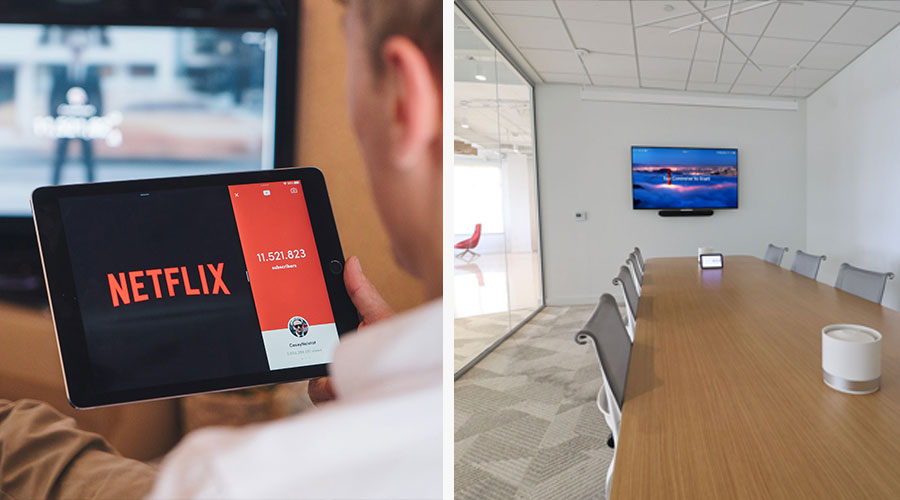
How Consumer Expectations Are Driving the Next Wave of Commercial AV Innovation
Did you know that more than 90% of employees use streaming services daily and nearly everyone interacts with voice assistants or video calls at home? Those habits are shaping what they expect in the workplace.
Imagine this: At home, your employees can stream a 4K movie with a voice command, hop on FaceTime in seconds, and control their entire environment with a smartphone. But when they walk into your conference room, they’re fumbling with remotes, adapters, and a dozen logins just to start a meeting.
That disconnect isn’t just frustrating, it’s reshaping the future of commercial AV. Today’s workforce, students, and customers don’t separate their personal tech experiences from their professional ones. If Netflix can deliver instant, seamless, and beautiful user experiences, why can’t your workplace or campus?
This shift in consumer expectation is driving some of the most important AV trends we’re seeing today. And for organizations willing to embrace it, the payoff goes far beyond convenience, it’s about ROI, competitive advantage, and reimagining how people connect in your spaces.
1. When Simplicity Becomes the Standard
Consumer tech has conditioned people to expect simplicity. Smartphones, streaming devices, and voice assistants set a new bar: everything should “just work.”
In commercial AV, this translates to frictionless meeting join, intuitive touch panels, and unified controls across every space. A boardroom with one-tap Zoom or Teams join doesn’t just meet expectations, it eliminates wasted minutes, reduces support calls, and ensures leaders walk into meetings with confidence.
To meet these expectations, organizations must think beyond hardware. They must ask: does our AV empower people to focus on work, or force them to fight with technology?
The business impact: Fewer disruptions, greater productivity, and measurable ROI from improved collaboration.
2. Living in an On-Demand World
Consumers live in a world where content is instantly available, whether it’s bingeing a series or watching a live event on social media. That expectation has carried over into business, education, and retail.
Enterprises now adopt streaming platforms for internal training, CEO town halls, and brand storytelling. Universities stream lectures to on-demand platforms so students can learn anytime, anywhere. Retailers broadcast live product launches to engage digital-first customers.
This consumer-driven demand for immediacy is redefining how organizations share knowledge and connect with audiences.
The business impact: Extended reach, stronger engagement, and competitive differentiation in how organizations communicate.
3. From Home to Office: Hybrid Consistency
The pandemic blurred the line between consumer and enterprise collaboration tools. Employees mastered Zoom, Teams, and Google Meet at home, and now expect the same seamless experience in the office.
Organizations are responding by standardizing AV across huddle rooms, conference spaces, and campuses. Consistency means employees no longer waste time learning new interfaces from room to room.
That consistency is more than convenience; it’s the difference between productive collaboration and disengagement.
The business impact: Higher employee satisfaction, reduced IT strain, and a stronger foundation for attracting and retaining talent in a competitive market.
4. Designing for Experience, Not Just Function
Consumers live in design-driven ecosystems. Apple devices, Tesla dashboards, even Netflix’s interface prove that technology isn’t just functional, it’s beautiful.
Now, commercial environments must follow suit. AV technology should blend with architecture, not distract from it. Corporate lobbies feature immersive video walls that tell brand stories. Hotels integrate discreet AV into luxury spaces so guests experience atmosphere, not equipment.
When AV is designed with aesthetics in mind, it ceases to be a tool and becomes part of the environment itself.
The business impact: Stronger first impressions, elevated brand identity, and environments that inspire confidence and loyalty.
5. Turning Data Into Strategy
Consumer platforms are data-centric, think Spotify Wrapped or Netflix recommendations. That same appetite for insights now shapes how executives view AV investments.
Advanced AV systems can track room utilization, analyze engagement with digital signage, and monitor device performance in real time. This transforms AV from a sunk cost into a measurable asset.
Data doesn’t just justify spend, it informs smarter long-term planning.
The business impact: Leadership gains the hard data they need to justify budgets, optimize spaces, and drive long-term strategy.
Conclusion: Meeting Consumer Standards to Win in Business
Consumer expectations are no longer staying at home, they’re shaping the conference room, the classroom, the lobby, and beyond. The organizations that understand this shift aren’t just installing new technology; they’re future-proofing their business.
The question isn’t whether consumer habits will influence commercial AV. They already are. The real question is: will your organization adapt quickly enough to turn those expectations into a competitive advantage?
Now is the time to evaluate your AV systems through the lens of consumer expectations, because what people experience at home is the benchmark they’ll bring into work.
Ready to bridge the gap between consumer expectations and your workplace technology? Contact our team today to start designing AV solutions that deliver seamless experiences and measurable ROI.

